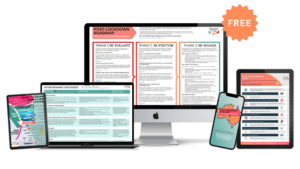Making sure your website is “content-rich” is an excellent way to significantly increase the number of visits to your website. A great way to add valuable and relevant content to your website is through blogs! This article will break down the process of creating blog content and show you how to write a good blog post that will encourage visitors to your website and build trust with your target market.
Step 1: Choosing a topic to write about
Write what you know and what your customers don’t!
Some business owners worry that they don’t have anything interesting to say. We would like to challenge that by reminding you that you are an expert in your field. Your blog content should solve a problem for your clients by shedding light on something they don’t know about or busting a myth that might be preventing them from engaging with you.
Examples:
- A nail salon could write a blog explaining the different types of manicures and the pros and cons of each type.
- A landscaper could write a blog about the type of garden set ups suitable for families with pets that is attractive, low-maintenance and avoids any plants that dogs may be allergic to.
- An accountant might write about the ways sole traders can track and record their expenses so that they aren’t left scrambling at tax time.
- An accommodation provider might write about all the great activities there are to do in winter in their destination.
You can also consider writing a “listicle” which is a blog post written out as a list, e.g. “Top 10 hairstyles of 2022”, “Top 5 mistakes new parents make when setting up a nursery”, or “8 different ways to get wine stains out of carpet”. These types of blogs are easy to write because you only need to dedicate a paragraph or two to each item on the list and cap it off with a good introduction at the start and summary at the end then, voila, your blog is done!
Step 2: Research your topic
While you probably already have the basics of your topic down, it’s always useful to conduct some research to find out more statistics and information about your topic to support your claims. Take note of important references so that you can state the source in case you do decide to quote any statistics or other information in your blog.
If you want to use content from other sources, it’s important to re-write them in your own words to avoid plagiarising another writer. Using a tool like Quillbot or Copy.ai can be a great help in that instance.
Step 3: Create an outline for your blog
Consider the key points you want to convey in your blog over a few paragraphs and create a list of how you will arrange them and your main point for each section.
Here’s what the nail salon might write if they were going to create the manicure blog example mentioned earlier:
Intro:
-
- Lots of manicure options these days, with different costs, styles of application, and maintenance associated with them
Paragraph 1: Acrylics
-
- Pros: Affordable, long-lasting, doesn’t damage the nail
Cons: Takes a longer time to apply, need to come back to the salon for removal
- Pros: Affordable, long-lasting, doesn’t damage the nail
Paragraph 2: SNS
-
- Pros: Higher cost, long-lasting, resistant to chips, very fast drying
- Cons: Need to come back to the salon for removal
Paragraph 3: Gel
-
- Pros: Quick application, Can be removed at home with acetone,
- Cons: Can remove at home, can damage nail if not removed properly
Conclusion
-
- What you choose to get depends on your budget, how long you need it to last, and whether you’re willing to come back to the salon to get it removed/updated
- Call to action is to check out our services here for price list and style options
In terms of the length of your article, the key is to go for quality over quantity. According to a 2021 study by BlogSpot, the best performing blogs in terms of SEO were 2,100-2,400 words. However, writing a long blog post purely for the sake of hitting the 2,000+ word count is not going to keep your audience engaged.
Step 4: Write your blog
Now let’s get to the good part. Writing doesn’t come naturally to everyone, but everyone can do it. Use the below advice to guide you in how to write a good blog post.
Introduction:
- 1-2 paragraphs
- Introduce the topic by talking about why this issue is important to the reader
- Summarise the key points of your article without going into too much detail
- Let the reader know what the purpose of your article is
- It can sometimes be useful to write your introduction last after you’ve written all your content
Paragraphs
- Each new paragraph should introduce a new sub-topic or viewpoint
- Don’t ramble, aim to keep paragraphs between 3-5 sentences long
- When in doubt use TEEL, a four-sentence paragraph writing rule you might remember from high school or university:
- T = Topic sentence that introduces what you’re talking about
- E = Explanation sentence to provide more information
- E = Evidence / example sentence to validate the topic
- L = Linking sentence that leads into the next paragraph
- It’s okay to use bullet points in some areas if you’re creating a list of information (like we are doing here), in some cases, this is actually quite useful
Summary/Conclusion
- Recap the reasons why this topic is important/relevant to your audience
- Summarise the key points
- Provide the reader with a call to action that provides them with a goal of what to do next. E.g. “explore these relevant products”, “book a consult with our friendly team”, “view our services”, etc.
Photos & Videos
- Including relevant photos, graphics, and video content is a great way to break up your content and keep it interesting
- Remember to use Alt-text on your images so that search engines can “read” them. It’s also important to do this so your content is accessible for people with vision impairments
Internal links
- Where possible, include links to other pieces of content on your website such as other blog posts. This is great for SEO.
How often should you post new blog content?
How often you post new blog content is up to you. As a broad rule, we typically recommend one new blog post per month. If you can, it might help you to batch create a few of them at once which you can then space out over the coming months and also use them to support your social media and email marketing content.
It’s understandable that blog writing probably isn’t the highest priority item on most small business owners’ to-do lists. Managing your staff, your stock, your clients, your cash flow, and everything else you need to look after day-to-day naturally feels far more pressing. However, it’s important to remember what your long term priorities are. And if attracting new customers features on your list of long-term goals, you should make some time for blog writing in your monthly marketing schedule.
Final Tips
Here are a few final thoughts that can help elevate your blogging just that little bit extra!
- Use a spelling/grammar checker like Grammarly to catch mistakes
- Get someone else to read over your blog before you publish
- Break your blog up into chunks with headings. This makes it easier for readers to skim your content to find the bits they want
- Share your blog in your email newsletters, feature it on your homepage, post it on your social media
- Milk the content for all it’s worth! Can you use pieces of your article to create more social media content such as Instagram/Facebook Stories or Reels?
- Use a SEO tool such as RankMath to ensure that your content is optimised for search engines. This will involve choosing a few key words or phrases that your audience is likely to search for in your article and headings.
Take action
Now that you know how to write a great blog post, your action is to create a shortlist of blog topics that your target audience would be interested in reading and start mapping out your blog outline!
Let us know in our Facebook Support Group what industry you are in and what topic you plan to write about!




